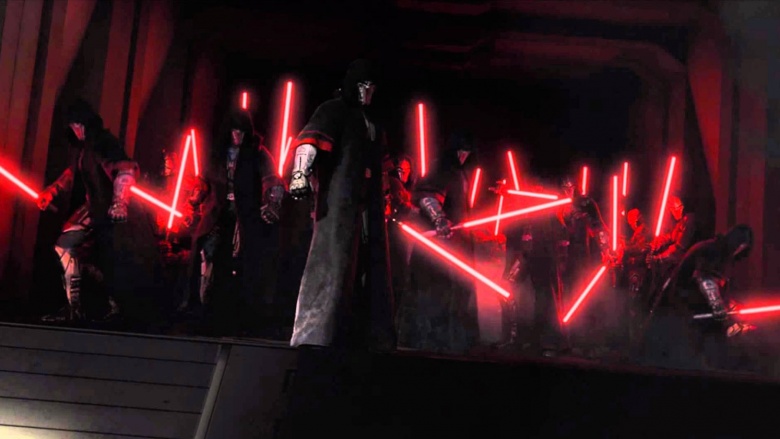The Real Reason Sith Lightsabers Are Red
We may receive a commission on purchases made from links.
Ever since Darth Vader made his first appearance on the big screen in the first installment of the original Star Wars trilogy in 1977, fans noted that Vader's lightsaber was a sinister red hue, while the lightsabers of other characters like Obi-Wan Kenobi and Luke Skywalker were blue. After the loss of his father's original lightsaber at Cloud City, Luke made another lightsaber—this time with a green blade. Many fans started to wonder: what causes the color of a lightsaber?
Are all Sith lightsabers red?
The Expanded Universe stories—now called "Legends" and considered to be non-canon material—established the lore behind lightsaber construction and introduced the idea that all Dark-side lightsabers are red. The Star Wars saga films continued to back up that concept, with Darth Maul, Darth Sidious, Darth Tyranus, and most recently, Kylo Ren all appearing with red-bladed lightsabers, while simultaneously introducing us to a rainbow of lightsaber colors wielded by Light-side Force users. The only canon instance where we see a Sith using a lightsaber with a color other than red is when Anakin Skywalker uses his original blade in the battle with Obi-Wan Kenobi on Mustafar. We'll explain why this makes sense later.
With Disney's purchase of the Star Wars franchise and the "Legends" canon pretty much thrown out of the window, the door has opened for new lore to be established regarding lightsaber construction and blade color. In the Star Wars novel Ahsoka by E.K. Johnston, the author has done just that—and it goes completely against everything you've been told before. So what's the official reason that Sith lightsabers are red? Here's the scoop.
Legends is out, new canon is in
For years, the official explanation behind Sith lightsaber color was related to the use of synthetic kyber crystals in Dark-side lightsaber construction. In a 2002 article in Star Wars Insider magazine, author David West Reynolds established the seven forms of lightsaber combat, as well as explaining that Sith were forced to use unstable synthetic kyber crystals—because Jedi controlled all of the natural crystals—and forged the synthetic crystals themselves, which caused the red coloration. Fans accepted that explanation for years, but Pablo Hidalgo gave us the first hint that the old explanation would soon be changing in a tweet from December 2015: "No, the synthetic crystal thing is Legends. Maul. Sidious. Vader. All those were kyber crystals."
Kyber crystals start out colorless
In Ahsoka, author E.K. Johnston reveals many secrets about Anakin Skywalker's ex-Padawan Ahsoka Tano and the Star Wars universe in general—including Ahsoka's near-abduction as a child and the oppression of Kashyyyk following the events in Revenge of the Sith. Additionally, we learn much about how a Jedi chooses a crystal to build their lightsaber with. According to the novel, a Jedi is "chosen" by a Force-sensitive kyber crystal, and all naturally-occurring kyber crystals are colorless. It is only during the "attuning" process that the crystal gains its final color, as reflected in the Jedi's blade.
Like blood from a stone
Not only are kyber crystals Force sensitive, they are naturally aligned with the Light side of the Force. Perhaps the most interesting reveal in Ahsoka is that—like Pablo Hidalgo suggested in 2015—Sith do not use synthetic crystals in their lightsabers. Because natural kyber crystals are attuned to the Light side of the Force, they naturally are resistant to a Dark side Force user. Sith cannot pluck a natural kyber crystal from the wild and use it—they would not be able to "attune" the crystal to them.
The only way that a Sith can use one is by stealing the crystal or lightsaber from a Jedi, or taking it from one they have defeated. At that point, it is possible for the Sith to then use their strength in the Force to bend the previous owner's kyber crystal to their will. This "bending" process causes the kyber crystal to essentially bleed like a living thing, resulting in the red color. No matter what color the crystal originally was, it will always be red in the hands of a Sith.
But what about Anakin?
As we previously mentioned, Anakin Skywalker used his original blade as a Sith while battling Obi-Wan Kenobi on Mustafar. But because this was already his blade and thereby already "attuned" to him, he didn't have to bleed it in order to continue wielding it. When he lost that original lightsaber, he was forced to construct a new one—with a crystal taken from an unknown source—which then had a red blade. During the fight with Yoda, a scene was filmed in which Count Dooku used Obi-Wan's blue lightsaber in addition to his own red one (which you can see in a production still from this Christopher Lee interview), but the scene was cut from the film and cannot be considered canon. So thus far, there's nothing that really conflicts with the new canon introduced in Ahsoka.
Wait, it gets better
E.K. Johnston didn't stop at bleeding kyber crystals—she also nicely tied in a point from Ahsoka's history that many fans wondered about. In some cases, it is possible for a Light side Force user to heal or purify a kyber crystal that was previously corrupted by a Sith. Ahsoka Tano herself is the only known example of a Force user who was able to do this, when she purified the crystals from the blades of the Sixth Brother, an Inquisitor she had killed after the end of the Clone Wars. Even though the crystals may be purified, they will never again return to their original color—instead becoming white. Ahsoka is later seen wielding these white-bladed lightsabers throughout the events of the Star Wars: Rebels animated series.
Pretty cool, huh?
So there you have it—Sith lightsabers are red because they contain stolen kyber crystals, which are literally bleeding from the trauma of being forced to bend to the Sith's will. Makes you feel kind of sorry for them, even if they are inanimate objects. Regardless, it definitely makes for a better origin story than "Sith use synthetic crystals they forge themselves." If you want to learn more, be sure to pick up E.K. Johnston's Ahsoka novel, which hits shelves October 11, 2016.







